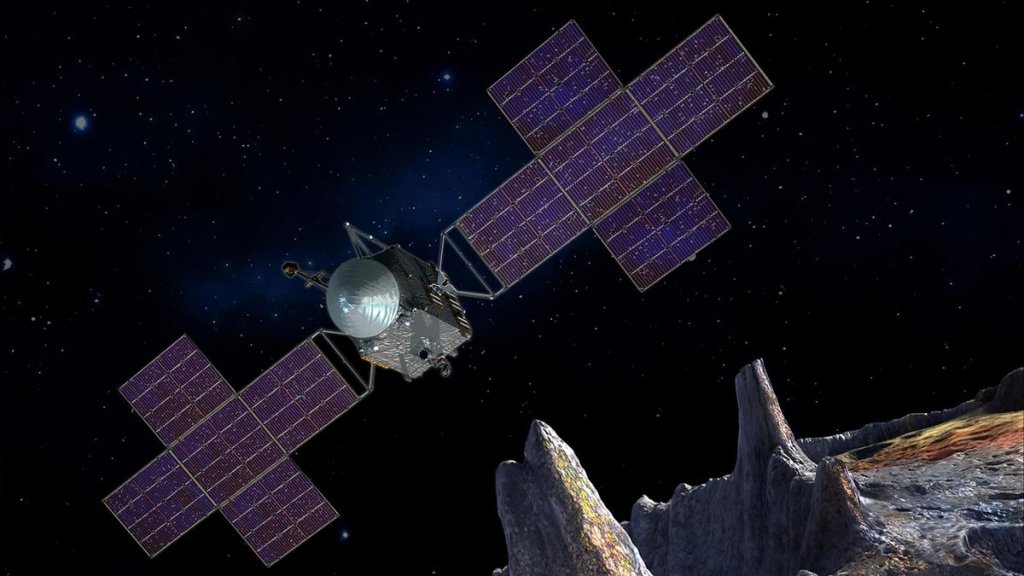On the morning of Oct. 12, if everything goes to plan, NASA will be sending a high-tech spacecraft called Psyche on a 2.2 billion mile journey to an intriguing asteroid by the same name. Well, to be clear, the asteroid is known as 16 Psyche.
The goal of the Psyche mission is to study this space rock in great detail because not only is it believed to be very metal-rich, but it’s also speculated to really be the leftover iron core of what once was a whole planet. And potentially, Earth‘s core is made of similar stuff — which means 16 Psyche could be offering us a direct tunnel to the center of our world, a place we cannot otherwise reach.
But before this mission starts falling into place, scientists are using other mechanisms to study the 140-mile-wide space rock. This way, we might know what’s in store for NASA‘s craft upon arrival in 2029. In fact, one team from the Southwest Research Institute recently announced some results they gleaned about the asteroid. These are results they collected by tapping into two powerful infrared instruments: The presently trailblazing James Webb Space Telescope (JWST) and the now-retired Stratospheric Observatory for Infrared Astronomy (SOFIA). Infrared sensors, unlike standard optical sensors, are able to observe data in the infrared region of the electromagnetic spectrum. Light associated with this region is, in essence, invisible to the human eye. We can only see a teeny portion of the spectrum known as, naturally, the visible region. But this is why infrared astronomy is so important — it can help reveal pieces of the universe normally hidden to us and our regular old telescopes.
Related: SpaceX fires up Falcon Heavy rocket ahead of Psyche asteroid mission launch
However, though data from these tools offered a significant-enough lens into 16 Psyche, perhaps the most thought-provoking finding was that they both reached a limit.
“All of the observations using different techniques keep showing us results that don’t make sense in context with each other,” Anicia Arredondo, a postdoctoral researcher at the SwRI and first author of a paper on the findings, said in a statement. “That’s why it’s so important that we have a mission going there now.”
“With this analysis and the previous studies of Psyche, we have reached the limit of what astronomical observations can teach us about this fascinating asteroid,” Maggie McAdam, a NASA Ames research scientist and principal investigator of the new study, said in a separate statement.
But they did find something. Sort of.
To begin, the team observed 16 Psyche in early 2022 with SOFIA — a flying observatory that’s essentially a Boeing 747 aircraft carrying a reflective telescope.
SOFIA, which stopped operations that same year due to its high operating costs, was able to scan the asteroid in the infrared range as the space rock rotated. In doing so, the telescope gathered information that the scientists say they can use to understand whether Psyche is the remnant core of a differentiated asteroid — an asteroid that underwent major chemical or physical changes — or a protoplanet.
“If so,” Arredondo said, “multiple impacts would have stripped all the outer layers off, leaving only a metal core. But those impacts could also lead to variability. However, observations indicate that Psyche is metal — no big surprise — and we don’t see a lot of variation with rotation, at least at the mid-infrared wavelengths.”
In a nutshell, the reason the team realized Psyche is most likely metal is that SOFIA’s spectral data (a graph of different forms of light emitted by the asteroid) didn’t have any spikes. It also didn’t have a feature known as the 10-micron plateau. These are things that suggest the presence of rock, the team says, such as ground resembling a “fluffy” regolith.
The JWST, on the other hand, helped the team determine whether water exists on the asteroid. “Observations across the 3- and 6-micron wavelength ranges tell us whether hydration is present in the form of hydroxyl or actual water,” Stephanie Jarmack, a research scientist at SwRI and member of the study team, said in the statement — hydroxyl referring to a molecule that consists of one oxygen atom and one hydrogen atom.
“If we don’t find it,” Jarmack continued, “that wouldn’t be surprising, considering Psyche is thought to be a mostly metallic world.” But now, the team says, we’ll have to wait until Psyche gets to Psyche in 2029 and starts employing its own technologies meant to study the elusive space rock.
For instance, the 6,056-pound (2,747 kilograms) explorer carries a multispectral imager that can photograph the asteroid in visible light wavelengths and near-infrared wavelengths; it has a gamma-ray and neutron spectrometer that can help reveal chemical elements that make up the rock’s surface; and a magnetometer that will look for proof of an ancient magnetic field on the subject. And that’s not even all of it.
“We need to physically visit Psyche to study it up close and learn more about what appears to be a very unique planetary body,” McAdam said.

